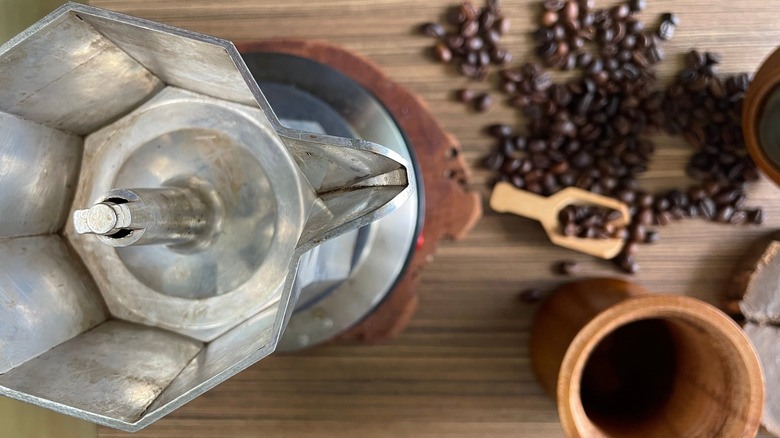The Right Way To Clean Stovetop Coffee Makers For The Best Tasting Cup
If you're a coffee enthusiast, then you most likely have a stovetop coffee maker, also known as a moka pot. This nifty device uses steam pressure to create a concentrated cup of coffee that is closer to espresso than a drip coffee. While it comes in handy to make a strong cup each morning, it can be somewhat confusing to clean. Do you scrub it clean with dish soap like your other coffee tools, or is there more delicate care involved? Fortunately, it's quite simple — all you need is a little bit of water.
After you finish brewing your cup, allow the pot to fully cool down so you don't singe your fingers. Once it has, unscrew its separate compartments and rinse each chamber with hot water. Use your fingers to rub out any lingering stains or residue. This is important since the leftover oil from the coffee can become burned during the next use, ruining your cup's taste. Once the moka is sufficiently clean, dry it with a clean microfiber cloth. You want to avoid adding any dish soap or running it through a dishwasher since the detergents used in both scenarios are too harsh and can embed themselves into the pot's surface. This can alter the taste of your coffee, giving it notes of soap. But what should you do if you start to notice buildup? You should still skip using soap, but there is a safer alternative.
How to clean a stovetop coffee maker with limescale
If you notice that your moka pot is starting to accumulate white residue, you will have to employ something a little stronger to break down the mineral buildup. This is limescale, and it's created when the minerals in the water are heated to such a degree that they solidify. However, if you see this, you want to avoid using soap. Instead, to easily remove limescale, reach for vinegar. Since vinegar is acidic, it helps eat away at the mineral deposits. But it does so with a specific chemical reaction. When it comes into contact with the calcium carbonate in the buildup, it turns it into a type of salt, which water then easily sloshes away.
Simply add water up to the fill line like you normally would when brewing a coffee, and instead of adding coffee grounds, add 2 teaspoons of vinegar to the water. Screw the top on, put the pot on the stove, and allow the water to boil and steam. When done, remove the cleaning mixture and rinse it with water to clear away any lingering residue. Then, to ensure your next morning cup doesn't taste acidic, you want to make three rounds of coffee, but throw away each one. This will remove any lingering aftertaste and replace it with your expected coffee flavor.
Alternative to vinegar to clean a moka pot
If you do not have vinegar on hand, you can also use citric acid. This citrus hack will easily remove hard water stains. The steps are the same: Fill the coffee maker to the line, add 2 teaspoons of citric acid to the water, put it on the stove, and brew sans coffee. Once done, rinse it with water and make three cups of coffee you will toss out to ensure the residue has been cleared. Just like with vinegar, the citric acid reacts with the calcium carbonate in the buildup, transforming it into a type of salt. Because of this, it doesn't matter if you choose vinegar or citric acid for your deep clean — pick whatever is more readily available to you.
As for how often you should be deep cleaning your coffee maker, you don't have to overdo it. While you should be rinsing the maker with hot water every time you use it, you can descale it after every 300 or so uses. If you use it frequently, this can equal about every three to four months. If you don't use it very often, this can expand into every six months or even a year. It all depends on the exact frequency.


